Porto Alegre, October 15th, 2024 – The Brazilian market is experiencing a situation in which growers have not shown a willingness to sell corn at any price in the second half of the year. The large volume of second-crop corn that exerts greater pressure on prices during the harvest has passed, and now we have a remaining volume that will depend on the needs for cash, space, and selling interest by growers. The aggressiveness of ethanol industries in purchases, the exporters’ focus on fulfilling logistics contracts, and firm domestic demand consolidate higher prices in the domestic market now.
The key to the Brazilian domestic market continues to be the volume of ongoing exports. This volume will determine either larger or fewer carryover stocks for 2025, easing or not the supply situation between February and June. Exports reached 26.5 mln tons last week, with October having 1.8 mln tons shipped and 5.8 mln total commitments for the month. A good volume for October. November is still slow in terms of the flow of commitments, but, based on the volume of business carried out by traders in the physical market for November and December, we must understand that the shipping volume would be at least 4 mln tons.
Thus, there are 14 mln tons left in the shipping schedule for Brazil to get closer to the business year target of 40 mln tons. One situation that is forcing exports is the logistic commitment of traders with railroads and ports, which establishes heavy fines in case of non-compliance with shipments. These fines suggest that it is better to ship corn even at above-normal price standards, rather than simply canceling logistic contracts. For this reason, deals at BRL 69/70/71 are seen in the ports of Santos and São Francisco, for example, with high premiums against the international market, 120/130 cents a bushel. Normally, these premiums would be close to 70/80 cents, mainly in the face of the US harvest. These logistics commitments should keep Brazilian exports strong until January, especially because with the delay in the soybean crop there will not be enough soybeans to fulfill the logistic contracts for December and January, imposing the need to ship corn.
Meanwhile, ethanol industries are adopting a stance of advancing purchases in key locations such as Mato Grosso and Mato Grosso do Sul, having risen prices last week. Business ended up evolving at BRL 50/53 in Mato Grosso and BRL 60/62 in Mato Grosso do Sul. With no sales pressure from these two states to other consumer states, prices also rose in the South region and São Paulo. Paraná and São Paulo set prices at BRL 65 in the interior, while Santa Catarina and Rio Grande do Sul went up to BRL 70. Minas Gerais had shown a more sudden upward movement due to retention. Now, offers have appeared and the market has settled down at BRL 62/65 in Triangulo Mineiro. Goiás, in turn, continues with a more aggressive buying position on the part of trading companies at up to BRL 58, and, after a good volume of business, offers were put at BRL 60.
In Matopiba, however, the excesses seem to have ended. There is now plenty of corn in warehouses and silo bags, but growers are trying to focus on offers at BRL 60. The issue is that this is now limited to the export account, since the domestic consumer is focused on the Sergipe crop that is just beginning.
Mathematically, there is still a good supply of regional corn to meet Brazilian domestic demand until the start of the summer crop. The issue is that growers are selling slowly and only what is necessary for the short term. The main focus is on the turn of the year, given the need for cash and freeing up space for the start of the soybean crop. Could we see some increase in regional offers during this period? It is likely, however, that there will also be greater buying interest on the part of trading companies and domestic consumers.
The main focus is really on the first half of 2025. Carryover stocks will be essential as the summer crop in the Center-South is clearly too small to meet all domestic demand during the period. The situation is aggravated by the fact that the second-crop planting will return to its traditional window, that is, January 20 and March 30, leaving harvests from July onward and not from May onward, as occurred in 2024. An extension of the off-season in the first half of the year requires a good strategy from big consumers, as well as strong attention from the domestic market to regional availability.
Safras News

